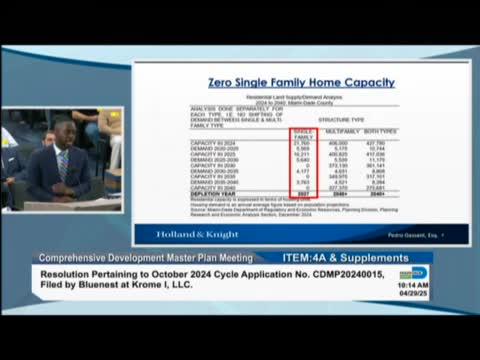County plans 20% workforce housing in new Southeast development to tackle affordability crisis
April 29, 2025 | Miami-Dade County, Florida
This article was created by AI summarizing key points discussed. AI makes mistakes, so for full details and context, please refer to the video of the full meeting. Please report any errors so we can fix them. Report an error »

The Miami-Dade County Board of County Commissioners convened on April 29, 2025, to discuss critical updates to the Comprehensive Development Master Plan and zoning regulations. A significant focus of the meeting was the urgent need for affordable housing in the county, as officials highlighted a projected depletion of residential land by 2027, which could exacerbate existing affordability issues.
The discussion centered on a proposed development aimed at addressing the "missing middle" in housing options, specifically through the introduction of townhomes. The county has seen a dramatic decline of 79.6% in housing priced below $500,000 between 2017 and 2024. In response, the proposed project aims to offer workforce housing units priced at a maximum of $451,000, significantly lower than the average home price of $665,000.
Details of the development were presented, including a breakdown of costs associated with purchasing a Blue Nest workforce housing home compared to renting. The analysis indicated that owning a home would be financially more advantageous over time, with potential savings of approximately $280,000 compared to long-term renting.
The site for the proposed development is located at the southeast corner of Chrome and Southwest 270 Second Street. Plans include a commitment to designate 20% of the units as workforce housing and to incorporate a commercial facility at the northwest corner to serve neighborhood retail needs. This aligns with the county's comprehensive plan to ensure a balanced distribution of land use and services for current and future populations.
The development will also address historical food desert conditions in the area by providing essential retail services within close proximity. The project is designed to include a variety of housing types, as mandated by county regulations for developments exceeding 40 acres, which in this case spans 90 acres.
Additionally, the proposal includes plans for connecting to water and sewer systems, moving away from septic systems, which is crucial for environmental sustainability and public health. The development is expected to generate significant tax benefits and impact fees, estimated at over $12.2 million, while also contributing to the local economy through job creation and improved infrastructure.
In conclusion, the meeting underscored the county's commitment to addressing housing shortages and enhancing community services, with the proposed development poised to play a vital role in meeting these objectives. Further discussions and approvals will be necessary as the project moves forward.
The discussion centered on a proposed development aimed at addressing the "missing middle" in housing options, specifically through the introduction of townhomes. The county has seen a dramatic decline of 79.6% in housing priced below $500,000 between 2017 and 2024. In response, the proposed project aims to offer workforce housing units priced at a maximum of $451,000, significantly lower than the average home price of $665,000.
Details of the development were presented, including a breakdown of costs associated with purchasing a Blue Nest workforce housing home compared to renting. The analysis indicated that owning a home would be financially more advantageous over time, with potential savings of approximately $280,000 compared to long-term renting.
The site for the proposed development is located at the southeast corner of Chrome and Southwest 270 Second Street. Plans include a commitment to designate 20% of the units as workforce housing and to incorporate a commercial facility at the northwest corner to serve neighborhood retail needs. This aligns with the county's comprehensive plan to ensure a balanced distribution of land use and services for current and future populations.
The development will also address historical food desert conditions in the area by providing essential retail services within close proximity. The project is designed to include a variety of housing types, as mandated by county regulations for developments exceeding 40 acres, which in this case spans 90 acres.
Additionally, the proposal includes plans for connecting to water and sewer systems, moving away from septic systems, which is crucial for environmental sustainability and public health. The development is expected to generate significant tax benefits and impact fees, estimated at over $12.2 million, while also contributing to the local economy through job creation and improved infrastructure.
In conclusion, the meeting underscored the county's commitment to addressing housing shortages and enhancing community services, with the proposed development poised to play a vital role in meeting these objectives. Further discussions and approvals will be necessary as the project moves forward.
View full meeting
This article is based on a recent meeting—watch the full video and explore the complete transcript for deeper insights into the discussion.
View full meeting